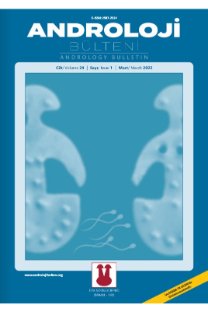Çalışma hayatının erkek üreme sağlığına etkisi
The impact of working life on men’s reproductive health
___
- 1. Awadalla NJ, El-Helaly M, Gouida M, Mandour R, Mansour M. Sperm chromatin structure, semen quality and lead in blood and seminal fluid of infertile men. Int J Occup Environ Med 2011;2:27–36.
- 2. Üreme Sağlığına Giriş. Ankara: T.C. Sağlık Bakanlığı, Ana Çocuk Sağlığı ve Aile Planlaması Genel Müdürlüğü, 2009. Erişim: https:// sbu.saglik.gov.tr/Ekutuphane/kitaplar/a%C3%A7sap40.pdf
- 3. Ören K, Yüksel H. Geçmişten Günümüze Çalışma Hayatı. Hak İş Uluslararası Emek ve Toplum Dergisi 2012;1:34–59.
- 4. Bilir N. Çalışma Hayatı ve Üreme Sağlığı. STED 2002;11:86–90.
- 5. Kim B, Park K, Rhee K. Heat stress response of male germ cells. Cell Mol Life Sci 2013;70:2623–36. doi: 10.1007/s00018-012- 1165-4
- 6. Pacey AA. Environmental and lifestyle factors associated with sperm DNA damage. Hum Fertil (Camb) 2010;13:189–93. doi: 10.3109/14647273.2010.531883
- 7. Dada R, Gupta NP, Kucheria K. Spermatogenic arrest in men with testicular hyperthermia. Teratog Carcinog Mutagen 2003;Suppl 1:235–43. doi: 10.1002/tcm.10050
- 8. Rubes J, Selevan SG, Evenson DP, et al. Episodic air pollution is associated with increased DNA fragmentation in human sperm without other changes in semen quality. Hum Reprod 2005;20:2776–83. doi: 10.1093/humrep/dei122
- 9. Sokol RZ, Kraft P, Fowler IM, Mamet R, Kim E, Berhane KT. Exposure to environmental ozone alters semen quality. Environ Health Perspect 2006;114:360–5.
- 10. Hammoud A, Carrell DT, Gibson M, Sanderson M, Parker-Jones K, Peterson CM. Decreased sperm motility is associated with air pollution in Salt Lake City. Fertil Steril 2010;93:1875–9. doi: 10.1016/j.fertnstert.2008.12.089
- 11. Kuloğlu M, Korkmaz S. Cep Telefonu ve Baz İstasyonlarının Nöropsikolojik Etkileri. Yeni Symposium 2011;49:99–105.
- 12. Sharma R, Biedenharn KR, Fedor JM, Agarwal A. Lifestyle factors and reproductive health: taking control of your fertility. Reprod Biol Endocrinol 2013;11:66. doi: 10.1186/1477-7827-11-66
- 13. Agarwal A, Deepinder F, Sharma RK, Ranga G, Li J. Effect of cell phone usage on semen analysis in men attending infertility clinic: an observational study. Fertil Steril 2008;89:124–8. doi: 10.1016/j.fertnstert.2007.01.166
- 14. Gutschi T, Mohamad Al-Ali B, Shamloul R, Pummer K, Trummer H. Impact of cell phone use on men’s semen parameters. Andrologia 2011;43:312–6. doi: 10.1111/j.1439-0272.2011.01075.x
- 15. Tekbaş ÖF. Kimyasallar ve Üreme Sağlığı. TSK Koruyucu Hekimlik Bülteni 2006;5:50–9.
- 16. Tiryaki O, Canhilal R, Horuz S. Tarım ilaçları kullanımı ve riskleri. Erciyes Üniversitesi Fen Bilimleri Enstitüsü Dergisi 2010;26:154– 69.
- 17. Carbone P, Giordano F, Nori F, et al. Cryptorchidism and hypospadias in the Sicilian district of Ragusa and the use of pesticides. Reprod Toxicol 2006;22:8–12. doi: 10.1016/j. reprotox.2006.01.006
- 18. Pierik FH, Burdorf A, Deddens JA, Juttmann RE, Weber RF. Maternal and paternal risk factors for cryptorchidism and hypospadias: a case-control study in newborn boys. Environ Health Perspect 2004;112:1570–6.
- 19. Bonde JP, Joffe M, Apostoli P, et al. Sperm count and chromatin structure in men exposed to inorganic lead: lowest adverse effect levels. Occup Environ Med 2002;59:234–42.
- 20. Jensen TK, Bonde JP, Joffe M. The influence of occupational exposure on male reproductive function. Occup Med (Lond) 2006;56:544–53. doi: 10.1093/occmed/kql116
- 21. Shiau CY, Wang JD, Chen PC. Decreased fecundity among male lead workers. Occup Environ Med 2004;61:915–23. doi: 10.1136/ oem.2004.014944
- 22. Frumkin H, Letz R, Williams PL, et al. Health effects of long-term mercury exposure among chloralkali plant workers. Am J Ind Med 2001;39:1–18.
- 23. Bonde JP. Male reproductive organs are at risk from environmental hazards. Asian J Androl 2010;12:152–6. doi: 10.1038/aja.2009.83
- 24. Robbins WA, Wei F, Elashoff DA, Wu G, Xun L, Jia J. Y:X sperm ratio in boron-exposed men. J Androl 2008;29:115–21. doi: 10.2164/jandrol.107.003541
- 25. Liu P, Hu W, Wu GP, Wei FS. Influence of professional boron exposure on quality of male sperms. Zhonghua Lao Dong Wei Sheng Zhi Ye Bing Za Zhi 2006;24:167–9.
- 26. Telisman S, Cvitković P, Jurasović J, Pizent A, Gavella M, Rocić B. Semen quality and reproductive endocrine function in relation to biomarkers of lead, cadmium, zinc, and copper in men. Environ Health Perspect 2000;108:45–53.
- 27. Pant N, Kumar G, Upadhyay AD, Patel DK, Gupta YK, Chaturvedi PK. Reproductive toxicity of lead, cadmium, and phthalate exposure in men. Environ Sci Pollut Res Int 2014;21:11066–74. doi: 10.1007/s11356-014-2986-5
- 28. Stellman JM. Perspectives on women’s occupational health. J Am Med Womens Assoc (1972) 2000;55:69–71, 95.
- 29. Jurewicz J, Hanke W, Sobala W, Merecz D, Radwan M. The effect of stress on the semen quality. Med Pr 2010;61:607–13.
- 30. Gollenberg AL, Liu F, Brazil C, et al. Semen quality in fertile men in relation to psychosocial stress. Fertil Steril 2010;93:1104–11. doi: 10.1016/j.fertnstert.2008.12.018
- ISSN: 2587-2524
- Yayın Aralığı: 4
- Başlangıç: 1999
- Yayıncı: Turgay Arık
Penil plikasyon tekniği uygulanan konjenital penil kurvatür sonuçları
Fuat KIZILAY, MEHMET ŞAHİN GÖK, Barış ALTAY
Cem YÜCEL, Mehmet Zeynel KESKİN, Özgür ÇAKMAK, Zafer KOZACIOĞLU
Ahmet TAHRA, Eyüp Veli KÜÇÜK, Abdurrahman İNKAYA
Erişkin gömük penis rekonstrüksiyonunda yeni suprapubik insizyon tekniği
HASAN YILMAZ, Murat ÜSTÜNER, Mustafa YÜKSEKKAYA, Mehmet Esat KÖSEM, Ali Kemal USLUBAŞ, Mustafa Melih ÇULHA
